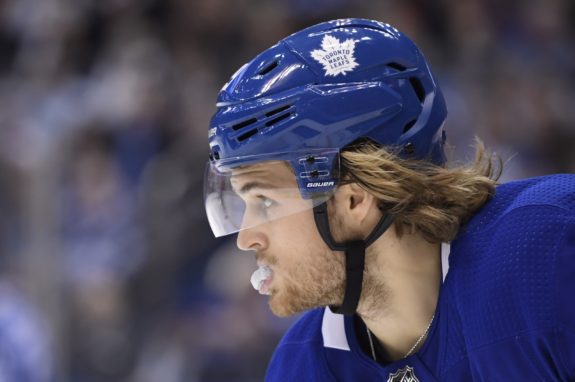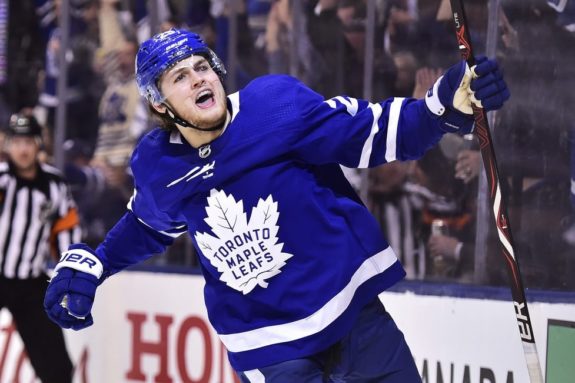You could fill a page with excuses.
He missed training camp and had a late start to the season.
He didn’t have his legs under him until January.
He spent a ton of time, especially in the playoffs, with weak linemates.
The list goes on and on.
The bottom line is that William Nylander’s showing this past season was not what the Toronto Maple Leafs wanted or expected from the player that they signed for nearly $7 million per season.
But while the 2018-19 season was certainly the worst of his career, the underlying numbers were still promising. And perhaps more importantly, Nylander’s larger body of work suggests that he is still a young star with plenty of untapped potential.
Underlying Numbers: 2018-19
Fans love to point to the box scores when evaluating players, but the reality is that hockey is a complicated sport that goes beyond just goals and assists.
Yes, Nylander’s mark of seven goals and 27 points over 54 games this past season sounds unimpressive on the surface, especially given his hefty new contract. The truth about the young Swede’s performance, however, lies in the finer details.

Nylander led the Leafs in possession at even strength with an impressive 56.77 percent Corsi for. He also ranked second in scoring chances for (SCF) at 58.26 percent and fifth in expected goals for (xGF) at 58.30 percent while on the ice.
Yet despite all of these great numbers, Nylander wasn’t rewarded accordingly.
The Leafs had just 53.60 percent of the goals when he was on the ice, almost five percent less than his xGF. This can largely be explained by his on-ice shooting percentage of 7.99 percent, which was amongst the worst on the team. While Nylander generated plenty of chances, neither he nor his linemates were able to convert as often as they should have.

These numbers tell us that Nylander drives possession and scoring chances at an incredible rate. In simple terms, when Nylander is on the ice his team is likely to control the puck, shoot, and score more than when he is off the ice. His elite skating, transitional play, and puck distribution allow him to do this, but because the box score results weren’t there this season, he didn’t get much credit.
Goal Scoring & Puck Luck
Perhaps what Nylander was criticized for most this season was his lack of goal scoring. No matter how you slice it, seven goals in 54 games isn’t pretty. But when you dig deeper into the numbers, it becomes apparent that he was a victim of bad puck luck more than anything. We can demonstrate this in a couple of ways.
First of all, Nylander shot a measly 5.38 percent this season, just slightly better than half his career mark of 9.8 percent. Before 2018-19, he was a career 11.11 percent shooter. This should already be raising some red flags.
We can extrapolate one step further. If Nylander shot at his previous career average of 11.11 percent this season, he would have scored 14 goals in 54 games. Over 82 games, that works out to 21 goals – right in line with his previous marks of 22 and 20 goals in 2017 and 2018, respectively.
“Bad puck luck” may sound like a mere excuse, but it’s actually quantifiable.

According to the quality and quantity of shots he took, measured by individual expected goals (ixG), Nylander should have scored 12 times. Of course, being an elite shooter or a poor shooter can influence how much a player scores relative to his expected goals. Auston Matthews, for example, scored 37 times despite an ixG of just 27 thanks to his unique shot release.
The thing about Nylander is that we know he’s actually an above average shooter based on his past performance. From 2015-16 to 2017-18 Nylander outperformed his 42 ixG, scoring 48 times over that span. And watching him shoot the puck, this makes perfect sense.
Nylander was unlucky and he will produce significantly better results moving forward. He did it for the two seasons prior, and there’s no reason to think that he can’t return to that form – and improve upon it.
Looking to Next Season
People love to get hung up on recent results in professional sports. “What have you done for me lately,” the fanatic beckons.
Hockey, though, is a volatile sport. Just as the best team doesn’t always win, the best players don’t always produce as they should.
The key is to remember the big picture.
Nylander just turned 23, can play both wing and centre, has recorded over 60 points twice, and actually had a decent season despite what mainstream media would have you believe.

With a summer of disappointment-fueled workouts plus a proper training camp in September, expect Nylander to come into next season with a chip on his shoulder. And if coach Mike Babcock reunites Nylander with Matthews, expect an offensive exhibition.
Given his current ability, Nylander is already good for 20-plus goals and 60-plus points. With proper usage, natural progression, and a whole lot of motivation, the 70-point plateau is not out of the question for 2020.
Nylander is more than his 2018-19 season. And that’s exactly what he needs to prove next season.
Stats from naturalstattrick.com